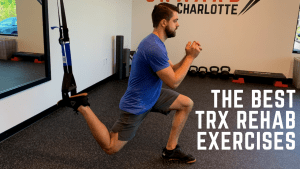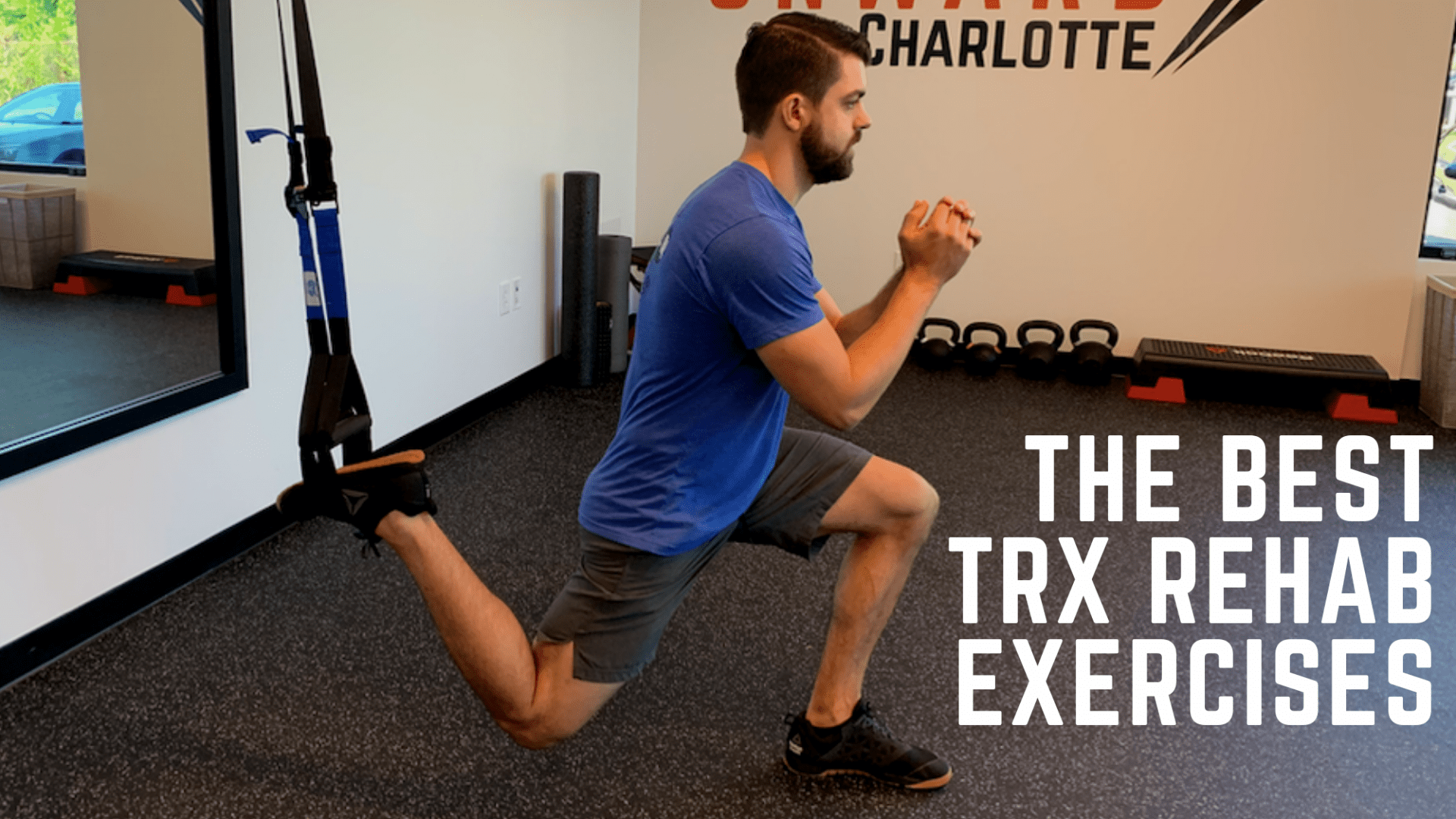TRX and other suspension trainers are one of the most versatile pieces of equipment for the physical therapist, chiropractor, or other rehab professionals to use in the treatment of injuries. The exercise variety and ease of quickly altering the load of the exercise makes it great for individuals of all fitness levels. I’m thrilled to share this compilation of the best TRX Rehab Exercises from some of the best rehab professionals I know.
If you would like to purchase a suspension trainer, I highly suggest looking at the Edge Suspension Trainer, which at only $59.99 is a fraction of comparable products, for the same high quality.
TRX REHAB EXERCISES
Wall Angels
Want a great warm-up exercise for a suspension trainer? Using one for wall angels allows you to easily progress and regress depending on your shoulder and thoracic mobility. You can also easily push backward to fire the upper back while working on mobility.
View this post on Instagram
Abdominal Fallouts
A challenging drill to maintain a neutral lumbar spine as the arms are raised overhead. Great for anyone needing anterior core strength and especially for the active population like CrossFitters, who move into excessive lumbar extensions with overhead lifting. This is one of my favorite TRX exercises for midline stability.
Zach Long, The Barbell Physio
TST (The Space Trainer) Bridge with KB Press
This exercise requires an incredible amount of anterior and posterior chain activation. The TST requires massive amounts of Tri-Planar Hip Stability with hip extension, external rotation, and abduction. This activation only increases the posterior chain engagement for full-body stability. So, the Single Arm KB Press is a great addition to confront anti-rotation and anterior chain activation. This exercise is a great bang for its buck to teach some clients and athletes full body irradiation.
View this post on Instagram
Dr. James Spencer, DC, ATC, FIAMA
Shoulder Field Goals
View this post on Instagram
Shoulder Field Goals are one of my favorite accessory exercises for shoulder health and overhead stability. Here, I demonstrate using the EDGE Suspension Trainer. The suspension trainer allows you to alter the difficulty by adjusting how far you stand from the system. The closer you stand, the more difficult it is, as you will be lifting more of your body-weight. Give the shoulder field goal a try to increase shoulder stability, a great exercise for both rehab and performance settings!
Michael Mash, DPT, CSCS, FMS
Facebook.com/barbellrehab Instagram.com/barbellrehab Twitter.com/mashdpt
Anterior Shoulder I’s, Y’s, & T’s
View this post on Instagram
The posterior shoulder gets all the love these days. But what about the flip side of the coin and anterior shoulder strength? Many patients’ shoulder symptoms are exacerbated by uncontrolled lengthening of the anterior chain. So, why not train this pattern in the later stages of rehab?
These 3 TRX rehab exercises are a great way to work on anterior chain control. The emphasis should be on maintaining a neutral lumbar spine, keeping inferior rib cage apposition, and eccentrically controlling scapula retraction/posterior tilt. This eccentric component may have additional benefits for those with myofascial restrictions in their anterior chain (i.e., pec minor).
I usually start supine to teach the proper technique/breathing. From there, I progress to suspension trainer isometrics, eccentric isometrics, then finally to the full motion.
Aaron Swanson, DPT, CSCS – Owner, Physical Therapist at The A&G Project
Facebook, Instagram, Twitter, YouTube
TRX Assisted Single Leg Deadlift Re-/Progressions
The TRX assisted Single Leg Deadlift is a great teaching tool to instruct a client on the proper way to perform a single leg deadlift. This TRX rehab exercise allows for the client to have increased stability and allows them to focus on proper hip and trunk positioning. You can progress from 2 hands to 1 or eventually to a hip airplane, as seen at the end of the video. If someone can perform with good form, then progress to a bodyweight or weighted version.
TRX Exercises: TBABs (Suspension Bridge with Banded Hip Abduction)
This TRX rehab exercise is an assisted bridge combined with a banded bilateral hip abduction (TBABs). This is an excellent exercise that heavily targets the gluteus medius while building hip and lumbar extensor isometric strength/endurance. It requires core strength, lumbar/hip extensor control, and directly targets the gluteus medius due to the hips being in neutral to slight extension.
One of the best features is that it is a non-weight bearing, which allows it to be used in cases when a patient or client might have weight-bearing restrictions on the ankle, knee, or hip. Additionally, you can easily spot a unilateral weakness in the hip abductors that might not show up as easily in gait or with MMT. This is because both hips have to abduct equally against each other to uniformly stretch the sport band and to keep from pulling too aggressively to one side and throwing the bridge off balance.
Jarod Hall, PT, DPT, CSCS
TRX Bird Dogs
TRX workouts performing bird dogs is a great way to train to move the hips separate from the pelvis and low back for some individuals dealing with injuries to these areas.
View this post on Instagram
Dr. Jacob Harden, Axis Sports Therapy
TRX Shoulder Warm-Ups
View this post on Instagram
Suspension trainers are a great tool that can deliver a full-body workout with great versatility. They’re also a great tool for warming up for a workout. Use these two shoulder movements with a suspension trainer before your next workout to help build resilient shoulder stability.
- Single Arm Plank Screwdriver: The Kettlebell screwdriver is a staple exercise for developing rotational control in a packed shoulder position. Take this movement to the next level by executing its single arm on a suspension trainer. Maintain a braced neutral spine, actively pull the shoulder back to a stable position in the shoulder girdle, and perform small rotational movements within your ability to control. Use both arms for a slightly less challenging variation.
- Single Arm Circles: Increase the intensity from the screwdriver to minicircles. Key points of performance from the previous movement are the same, but the stability demands of the shoulder are increased with increased movement in three planes. Start small, complete clockwise and counterclockwise motions, before increasing motion diameter.
Mitch Babcock, UnchainedPhysio.com
Redcord Variation of 4PK Hip Extension
View this post on Instagram
This is a suspension trainer version and the advanced progression of a commonly taught exercise focussing on hip extension on all four’s. I love it because it shows the person how much control they need in their shoulders and weight-bearing hip to successfully extend the other side. You can’t afford to arch your back or sway to the side, both of which are common movement compensations.
When performing the hover in the redcord, if you lose your base of support, you can’t stay balanced. Great for scapula and shoulder stability, neck extension endurance, abdominal control, hip extension movement training, and balance.
Sian Smale, Australian-trained Musculoskeletal Physiotherapist (currently a Californian License Applicant)
www.raynersmale.com Twitter Instagram Facebook
Rows with a Twist
This advanced TRX Rehab Exercise is highly effective for injury recovery of the shoulder, midback, low back, and diastasis recti. Teaching your body how to coordinate and work together will help get you to 100% on your rehab goals as well as prevent future injury. It combines a row using the muscles in your midback to retract the scapula (shoulder blade) with the muscles of your entire core to brace your spine.
Dr. Sarah Ellis Duvall, PT, DPT, CPT, owner of Core Exercise Solutions
TRX Sprinter’s Start
View this post on Instagram
Dr. Mario Novo of LiftersClinic.com
Jackknife Plus Plache Rocks
View this post on Instagram
Dave Tilley, Shift Movement Science
Face Pull
While there is no one size fits all approach to rehabilitation or performance training, I haven’t met very many clients who wouldn’t benefit from adding some scapular retraction and external rotation work to their program. The face pull, which is essentially a combination of a horizontal row and external rotation, targets both these movements at once.
The exercise can be broken down into its parts, but I like to perform it in one smooth movement for several reasons. The integration and fluidity in the single movement get the cuff and periscapular muscles firing together and working as a unit throughout the entire range of motion. I have also found that clients pick up the exercise much quicker when they perform it this way.
To perform this exercise, take all of the slack out of the TRX, and stand straight with your arms in a 90/90 position. This will be the finishing position. Slowly lower yourself by simultaneously internally rotating your shoulder and protracting your scapulae. If it is too difficult to come back up from this position, start the next rep with your feet further back.
TRX Single Leg Squat
The single-leg squat is a great way to build strength in the lower extremity and a great TRX rehab exercise. Most of my athletes get a heavy dose of single leg work when they begin training, during GPP phases, or as they rehab from injury. But, they will need great single-leg stability, strength, and power to compete to the best of their ability. The TRX gives some additional upper body control, which can allow us to focus on the work performed by the lower extremity. I like to perform the movement in two variations:
Variation 1: Hold the handles with the elbows close and balance on one leg keeping the big toe, little toe, and heel on the ground. Slowly bend at the knee, allowing the hips to go down and back as the opposite leg stays out in front. Be sure to control the downward eccentric phase of the movement and fully lock the hip out at the top. Cue the athlete to maintain an upright torso.
Variation 2: Same squat as above, but tuck the other leg behind the balance leg. I find this variation better mimics the explosive/acceleration work we may need our athletes to perform.
Jackson Taylor Prevail Strength and Conditioning www.areteparadigm.com







